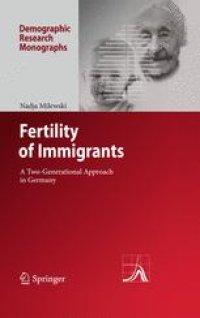
Ebook: Fertility of Immigrants: A Two-Generational Approach in Germany
Author: Dr. Nadja Milewski (auth.)
- Tags: Demography, Population Economics, Education (general), Statistics for Social Science Behavorial Science Education Public Policy and Law, Migration, Regional and Cultural Studies
- Series: Demographic Research Monographs
- Year: 2010
- Publisher: Springer-Verlag Berlin Heidelberg
- Edition: 1
- Language: English
- pdf
This book examines fertility patterns of post-war labor migrants and their descendants in Germany. It includes an introduction to the post-war migration history of Germany and a thorough review of the international literature on fertility of migrants and cultural sub-groups. The author uses data from the German Socio-economic Panel Study and applies event-history techniques to test a set of competing hypotheses derived from the literature. The analysis finds evidence for the effects of adaptation, socialization and composition, as well as for an interrelation of events. It does not however find evidence for a disruptive influence of migration on childbearing behavior. The book shows the advantages of a longitudinal research design over the conventional cross-sectional approach and sets a new standard for research on the fertility of international migrants and their descendants in western European receiving societies.
This book examines fertility patterns of post-war labor migrants and their descendants in Germany. It includes an introduction to the post-war migration history of Germany and a thorough review of the international literature on fertility of migrants and cultural sub-groups. The author uses data from the German Socio-economic Panel Study and applies event-history techniques to test a set of competing hypotheses derived from the literature. The analysis finds evidence for the effects of adaptation, socialization and composition, as well as for an interrelation of events. It does not however find evidence for a disruptive influence of migration on childbearing behavior. The book shows the advantages of a longitudinal research design over the conventional cross-sectional approach and sets a new standard for research on the fertility of international migrants and their descendants in western European receiving societies.
This book examines fertility patterns of post-war labor migrants and their descendants in Germany. It includes an introduction to the post-war migration history of Germany and a thorough review of the international literature on fertility of migrants and cultural sub-groups. The author uses data from the German Socio-economic Panel Study and applies event-history techniques to test a set of competing hypotheses derived from the literature. The analysis finds evidence for the effects of adaptation, socialization and composition, as well as for an interrelation of events. It does not however find evidence for a disruptive influence of migration on childbearing behavior. The book shows the advantages of a longitudinal research design over the conventional cross-sectional approach and sets a new standard for research on the fertility of international migrants and their descendants in western European receiving societies.
Content:
Front Matter....Pages i-xxi
Introduction....Pages 1-17
Theory and Empirical Findings in Previous Investigations....Pages 19-77
Empirical Analysis....Pages 79-131
Discussion....Pages 133-144
Summary....Pages 145-148
Erratum....Pages 177-177
Back Matter....Pages 149-176
This book examines fertility patterns of post-war labor migrants and their descendants in Germany. It includes an introduction to the post-war migration history of Germany and a thorough review of the international literature on fertility of migrants and cultural sub-groups. The author uses data from the German Socio-economic Panel Study and applies event-history techniques to test a set of competing hypotheses derived from the literature. The analysis finds evidence for the effects of adaptation, socialization and composition, as well as for an interrelation of events. It does not however find evidence for a disruptive influence of migration on childbearing behavior. The book shows the advantages of a longitudinal research design over the conventional cross-sectional approach and sets a new standard for research on the fertility of international migrants and their descendants in western European receiving societies.
Content:
Front Matter....Pages i-xxi
Introduction....Pages 1-17
Theory and Empirical Findings in Previous Investigations....Pages 19-77
Empirical Analysis....Pages 79-131
Discussion....Pages 133-144
Summary....Pages 145-148
Erratum....Pages 177-177
Back Matter....Pages 149-176
....